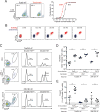Identification of Natural Regulatory T Cell Epitopes Reveals Convergence on a Dominant Autoantigen
- PMID: 28709804
- PMCID: PMC5562039
- DOI: 10.1016/j.immuni.2017.06.015
Identification of Natural Regulatory T Cell Epitopes Reveals Convergence on a Dominant Autoantigen
Abstract
Regulatory T (Treg) cells expressing the transcription factor Foxp3 are critical for the prevention of autoimmunity and the suppression of anti-tumor immunity. The major self-antigens recognized by Treg cells remain undefined, representing a substantial barrier to the understanding of immune regulation. Here, we have identified natural Treg cell ligands in mice. We found that two recurrent Treg cell clones, one prevalent in prostate tumors and the other associated with prostatic autoimmune lesions, recognized distinct non-overlapping MHC-class-II-restricted peptides derived from the same prostate-specific protein. Notably, this protein is frequently targeted by autoantibodies in experimental models of prostatic autoimmunity. On the basis of these findings, we propose a model in which Treg cell responses at peripheral sites converge on those self-proteins that are most susceptible to autoimmune attack, and we suggest that this link could be exploited as a generalizable strategy for identifying the Treg cell antigens relevant to human autoimmunity.
Keywords: Aire; autoantibodies; autoantigens; autoimmune regulator; autoimmunity; immune tolerance; prostate cancer; regulatory T cells.
Copyright © 2017 Elsevier Inc. All rights reserved.
Figures




Similar articles
-
Aire Enforces Immune Tolerance by Directing Autoreactive T Cells into the Regulatory T Cell Lineage.Immunity. 2016 May 17;44(5):1102-13. doi: 10.1016/j.immuni.2016.02.009. Epub 2016 Apr 26. Immunity. 2016. PMID: 27130899 Free PMC article.
-
Adaptation of TCR repertoires to self-peptides in regulatory and nonregulatory CD4+ T cells.J Immunol. 2007 Jun 1;178(11):7032-41. doi: 10.4049/jimmunol.178.11.7032. J Immunol. 2007. PMID: 17513752
-
Autoimmune thyroiditis: a model uniquely suited to probe regulatory T cell function.J Autoimmun. 2009 Nov-Dec;33(3-4):239-46. doi: 10.1016/j.jaut.2009.09.004. Epub 2009 Oct 12. J Autoimmun. 2009. PMID: 19822405 Free PMC article. Review.
-
Thymic commitment of regulatory T cells is a pathway of TCR-dependent selection that isolates repertoires undergoing positive or negative selection.Curr Top Microbiol Immunol. 2005;293:43-71. doi: 10.1007/3-540-27702-1_3. Curr Top Microbiol Immunol. 2005. PMID: 15981475 Review.
-
T cell reactivity to MHC class II-bound self peptides in systemic lupus erythematosus-prone MRL/lpr mice.J Immunol. 2003 Feb 15;170(4):2229-35. doi: 10.4049/jimmunol.170.4.2229. J Immunol. 2003. PMID: 12574397
Cited by
-
Next-generation regulatory T cell therapy.Nat Rev Drug Discov. 2019 Oct;18(10):749-769. doi: 10.1038/s41573-019-0041-4. Epub 2019 Sep 20. Nat Rev Drug Discov. 2019. PMID: 31541224 Free PMC article. Review.
-
How Thymocyte Deletion in the Cortex May Curtail Antigen-Specific T-Regulatory Cell Development in the Medulla.Front Immunol. 2022 May 25;13:892498. doi: 10.3389/fimmu.2022.892498. eCollection 2022. Front Immunol. 2022. PMID: 35693793 Free PMC article.
-
Foxp3+ Regulatory and Conventional CD4+ T Cells Display Similarly High Frequencies of Alloantigen-Reactive Cells.Front Immunol. 2019 Mar 19;10:521. doi: 10.3389/fimmu.2019.00521. eCollection 2019. Front Immunol. 2019. PMID: 30941146 Free PMC article.
-
Expansion of tumor-associated Treg cells upon disruption of a CTLA-4-dependent feedback loop.Cell. 2021 Jul 22;184(15):3998-4015.e19. doi: 10.1016/j.cell.2021.05.027. Epub 2021 Jun 21. Cell. 2021. PMID: 34157302 Free PMC article.
-
Towards the development of next-generation lung cancer immunotherapy.Transl Lung Cancer Res. 2025 Jun 30;14(6):2257-2271. doi: 10.21037/tlcr-2024-1097. Epub 2025 Jun 25. Transl Lung Cancer Res. 2025. PMID: 40673103 Free PMC article. Review.
References
-
- Anderson MS, Venanzi ES, Klein L, Chen Z, Berzins SP, Turley SJ, von Boehmer H, Bronson R, Dierich A, Benoist C, Mathis D. Projection of an immunological self shadow within the thymus by the aire protein. Science. 2002;298:1395–1401. - PubMed
-
- Barnden MJ, Allison J, Heath WR, Carbone FR. Defective TCR expression in transgenic mice constructed using cDNA-based alpha- and beta-chain genes under the control of heterologous regulatory elements. Immunol Cell Biol. 1998;76:34–40. - PubMed
Publication types
MeSH terms
Substances
Grants and funding
LinkOut - more resources
Full Text Sources
Other Literature Sources
Medical
Molecular Biology Databases
Research Materials

